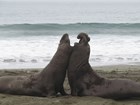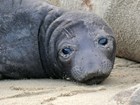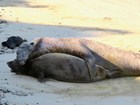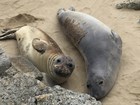Read stories of the elephant seal pupping season through the eyes of Point Reyes Natioinal Seashore's volunteers.
-
Point Reyes National Seashore
Article 1: December: Male Elephant Seals Arrive—and Let Us Know They Are Here

Elephant seals make a LOT of noise! Anyone who visits either the Elephant Seal Overlook at Chimney Rock or Drakes Beach over the next weeks will be struck immediately by the racket that raucous male elephant seals make. At first, the cacophony sounds like a random assortment of burps and belches, clicks and snorts. But the vocalizations are not random—they are, in fact, a complex and essential element in establishing hierarchy. Read more
-
Point Reyes National Seashore
Article 2: January: Pups, Pups, Pups! – Bringing Forth the Next Generation

January is a jam-packed, happening month for female elephant seals. When the cows, as females are known, turn up on Point Reyes beaches around the start of January, they are pregnant and ready to give birth after their months-long feeding trip. Within days, they give birth and start nursing their single pups, all the while fasting. Then, a few weeks later, just as they are weaning their pups, they enter estrus, mate, and head back out to sea. Read more
-
Point Reyes National Seashore
Article 3: February: Mating and Impregnation – It's Complicated!

When It comes to elephant seal mating, "There is no wining and dining," according to Winter Wildlife Docent Peggy McCutcheon. February is a wild month for elephant seal bulls and the cows they are pursuing. The competition and urge to mate is strong and can seem harsh by human standards. But the seals survive, and the pregnant females employ a special strategy to ensure the survival and development of their newly fertilized eggs. Read more
-
Point Reyes National Seashore
Article 4: March: Catastrophic Molt: It's Not As Bad As It Sounds

Anything with "catastrophic" in its name sounds seriously bad, however the catastrophic molt is a regular occurrence in the life of an elephant seal. Read why it's "catastrophic," learn about the continuing story of the life of a recently weaned pup, understand how elephant seals are monitored, and meet some of the volunteers who help protect and educate visitors about these animals who live a life of extremes. Read more
